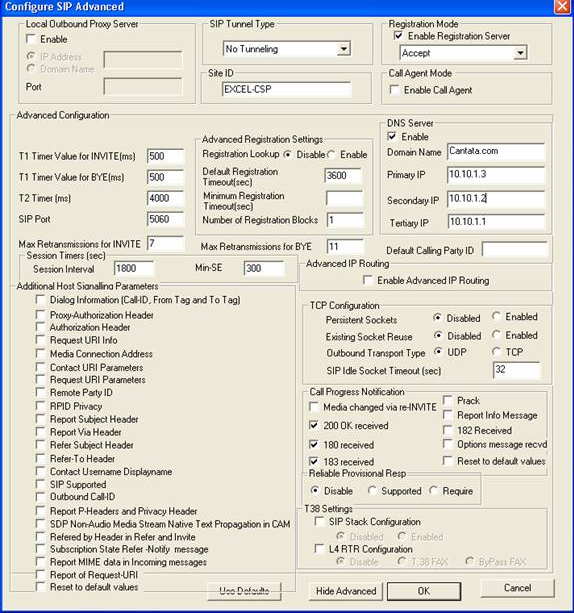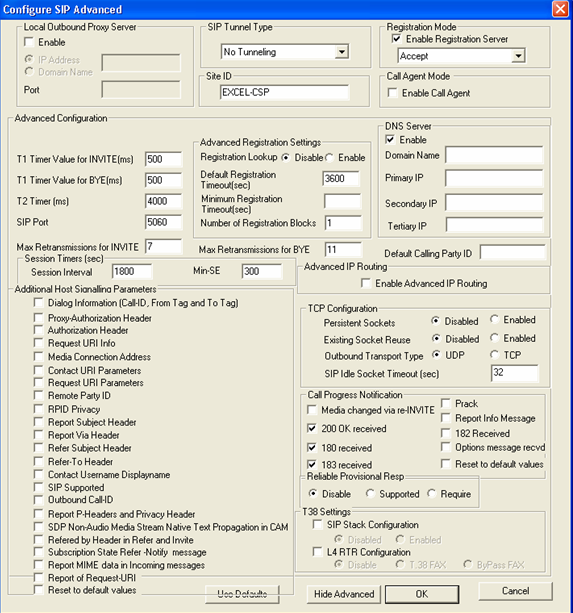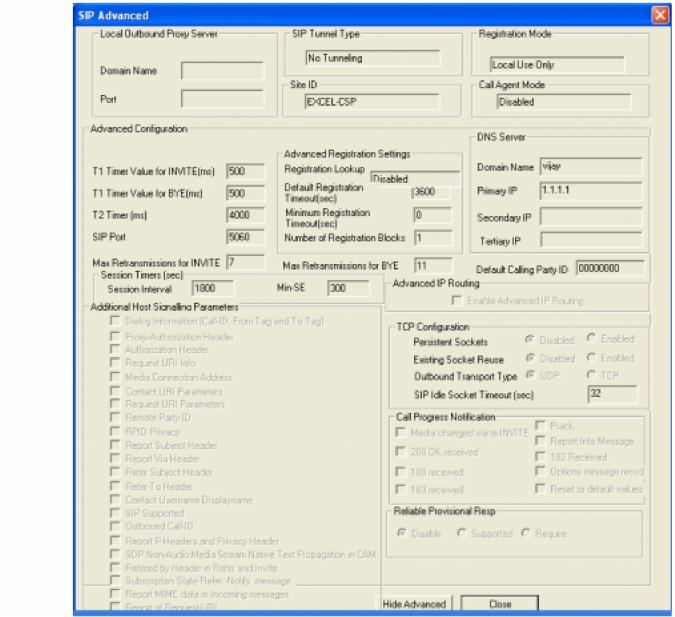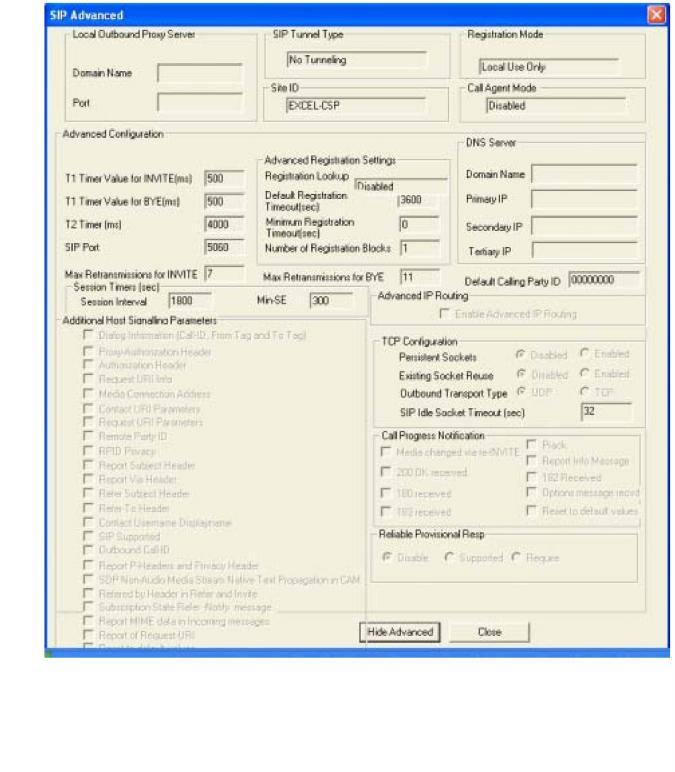
You are here: CSP Developer’s Guide: Internet Protocol > 5 Session-Initiation Protocol (SIP) Software > Disabling the SIP Domain Name System (DNS) Server
Disabling the SIP Domain Name System (DNS) Server

Overview
Prior to this feature, you enabled and disabled the Domain Name System (DNS) Server at the card level. The DNS task and a UDP socket, used to contact the DNS Server, is created when the CSP Matrix Series 3 Card boots up. Disabling the DNS Server disables the DNS functionality in the CSP Matrix Series 3 Card.
Important! By default, the DNS Server is not configured (disabled).
Once the DNS Server is configured in the CSP SIP stack, there was no provision to disable the DNS Server lookup.
This feature allows the host application to disable the DNS Server lookup at any time. Disabling the DNS Server stops the CSP from sending outbound SIP calls requesting a DNS Server lookup.
API Messages
This feature requires the following API messages, TLVs and a new Response Status Value (NACK):
API Messages (Unmodified)
• VoIP Protocol Configure (0x00EE)
• VoIP Protocol Query (0x00EF)
TLVs (Unmodified)
• DNS IP Address (0x01D6)
• Default Domain Name (0x01D7)
Response Status Value NACK (New)
• DNS Server Disabled (0x1312)
|
Hex ID |
Name |
Description as necessary |
|
13 12 |
DNS Server Disabled (NACK)
|
All Route/Outseize Control API messages are nacked with this response if the outbound SIP call requires a DNS Server lookup and the DNS is disabled. |
Configuring with API
Disable the DNS Server
To disable the DNS Server, use the DNS IP Address TLV (0x01D6) to set the Primary, Secondary and Tertiary DNS IP addresses to zero. The host then sends the DNS IP Address TLV in the VoIP Protocol Configure (0x00EE) message to the CSP SIP stack to disable the DNS Server.
By disabling the DNS Server, all outbound SIP calls that require DNS lookup fail and be indicated by a NACK value of 0x1312. This NACK value applies to the Outseize Control (0x002C) and Route Control (0x00E8) messages.
When the host instructs the CSP Matrix Series 3 Card to disable the DNS Server, the following occurs:
• The Primary, Secondary and Tertiary DNS Server IP addresses are cleared (set to 0).
• The DNS Server is cleared.
• All DNS Server lookup requests queued up from SIP are NACKed with the failure status 0x01312.
• The most recent look-up cache will be cleared.
Enable the DNS Server
When host application configures (enables) the DNS Server, the destination address for the UDP socket must be configured. You must have the host application do the following:
1. Have the DNS IP Address TLV (0x01D6) set the Primary, Secondary and Tertiary DNS Server IP addresses within the VoIP Protocol Configure (0x00EE) message.
• Initially, the destination address for the UDP socket is set to the primary DNS IP address and the DNS task state is changed to DNS_SOCK_STATE_PRIM.
• If the primary DNS IP address cannot be reached and if the secondary DNS IP address is configured, then the secondary DNS is contacted. On changing the contact to the secondary DNS, the destination address for the UDP socket is changed accordingly and the DNS task state is changed to DNS_SOCK_STATE_SEC.
• If the secondary primary DNS cannot be reached and if the tertiary DNS address is configured, then the tertiary DNS is contacted. On changing to tertiary DNS, the destination address for the UDP socket is changed accordingly and the DNS task state is changed to DNS_SOCK_STATE_TER.
• The DNS request for look-up fails after three attempts.
2. Have the Default Domain Name TLV (0x01D7) set the domain name within the VoIP Protocol Configure (0x00EE) message. This configuration can be queried using the VoIP Protocol Query (0x00EF) message.
Query the DNS Server Configuration
The DNS Server configuration for SIP can be queried using the VoIP Protocol Query (0x00EF) message.
• If the DNS Server is disabled, the DNS IP Address TLV (0x01D6) and the Default Domain Name TLV (0x01D7) will be absent in the query response.
• If the DNS Server is enabled, the DNS IP Address TLV (0x01D6) is present in the query response and the Default Domain Name TLV (0x01D7) will be present if it was configured.
• If the Default Domain Name TLV (0x01D7) is returned in the query response it means the domain name was configured. If the TLV is absent in the query response it means that the domain name was not configured or the DNS is disabled.
Configuring with CSA
Enabling the DNS Server
Enable the DNS by entering the Domain name, Primary IP address, Secondary IP address and Tertiary IP address.
The host application uses the DNS IP Address TLV (0x01D6) to set the DNS IP addresses, and the Default Domain Name TLV (0x01D7) to set the domain name within the VoIP Protocol Configure (0x00EE).

Disabling the DNS Server
To disable the DNS check the Enable box and leave the Domain name, Primary IP address, Secondary IP address and Tertiary IP boxes empty.

DNS Server with Monitor Mode Enabled
The following shows the DNS Server box when enabled in the Monitor Mode.

DNS Server with Monitor Mode Disabled
The following shows the DNS Server box when disabled in the Monitor Mode.
